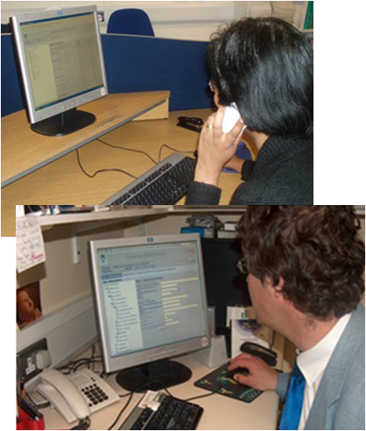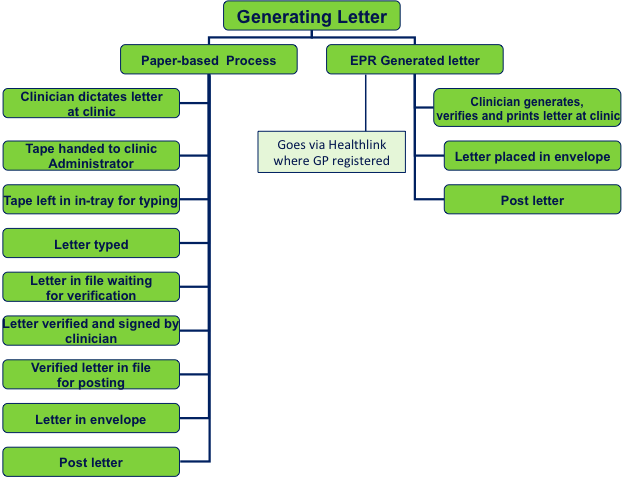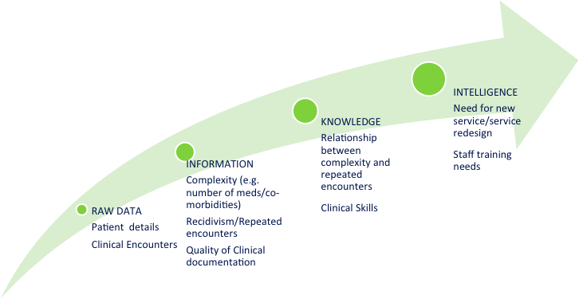Epilepsy EPR - Chronic Disease Management Case Study
Written by Mary Fitzmaurice
Introduction
In epilepsy, as with other chronic conditions, advances in medical science are resulting in improvements in health and a greater quality of life. Coupled with this evolution are increases in diagnostic and therapeutic complexity and a consequent burgeoning strain on health care systems. Throughout the world, traditional models of health service delivery are struggling to meet existing demand and are unlikely to cope with demand in the future. To maximise benefits of medical science advances to the patient while minimising the burden on healthcare systems, there is an international move to transform the way chronic disease is managed. This realignment is also reflected in Irish health service reports and strategies which recommend better integration of healthcare across organisational boundaries that are facilitated with information and communication technology (ICT).
In Ireland, the epilepsy care domain is leading the way in exploiting ICT to improve management of care for people with chronic conditions. A consortium of clinicians, ICT experts, health service researchers and health policy experts came together to design, develop and implement a secure web-based electronic patient record (EPR) which is now in daily use supporting clinical care of people with epilepsy across Ireland. The same health record can now be available to authorised healthcare providers at any location thus promoting safe and efficient integrated health care.
The Challenge
Epilepsy is a chronic neurological disease affecting at least 37,000 people in Ireland. Its diagnosis and optimal management relies on input from a number of healthcare disciplines (e.g. medical, nursing, psychology, administration ) in a variety of healthcare settings (e.g. community, primary care, specialist hospital ) together with the active participation of the patient (and/or family/carer). However, traditional models of healthcare delivery lack integration and can result in uncoordinated patient care, conflicting advice, and delays in diagnosis and treatment.
A lack of shareable patient records contributes to this fragmentation. Patient medical records are still largely paper-based with each healthcare agency keeping its own exclusive records. This limits the sharing and communication of information required to provide continuity of care across the multiple healthcare providers involved in the care of people wth chronic conditions. For example, in a paper-based system:
-
a medical record can only be in use by one person at a time,
-
unecessary delays in clinical decision making can result while waiting for a record to be retrieved from the medical records department,
-
there can be significant redundancy with regular unnecessary repetition of information gathering and diagnostic investigation when the patient’s record is not readily accessible,
-
poor access to clinical information can also result in improper use of emergency department services and innapropriate hospital admissions,
-
health service monitoring and evaluation can be labour intensive and data is not in the necessary standardised format.
An integrated electronic patient record (EPR), stored centrally can improve this situation so that the same health record can be available to all authorised healthcare providers regardless of geographical location. The benefits are that the same patient information is available to each discipline involved in patient care, multiple users of the record can have simultaneous access to the record, and an electronic record is more readily interrogated than paper records.
The Solution
In recognition of an unmet demand and steadily increasing need for epilepsy care throughout Ireland, this project aimed to:
-
Maximise effectiveness of, and enhance epilepsy care resources by incorporating a novel state-of-the-art EPR into service delivery;
-
Increase quality and value in the epilepsy patient care chain;
-
Improve integration of epilepsy services both within and between healthcare agencies;
-
Empower people with epilepsy to play a more active role in their healthcare;
-
Monitor and evaluate the performance of our epilepsy care by interrogating data stored in the EPR to show key performance indicators.
These objectives were achieved by a collaboration between clinical practitioners, academics, and ICT experts who together investigated how shared information can improve quality of care. The work involved engagement with people with epilepsy and their carers, and healthcare providers from multiple health service organisations who are involved in epilepsy care: epileptologists, epilepsy specialist nurses, epilepsy researchers, administrative personnel, general practitioners, general practice nurses, community nurses.
This analysis of the business of epilepsy care in Ireland informed the requirements for the development of an epilepsy EPR. In an iterative process of design, development and implementation, these requirements were translated by software engineers into the epilepsy EPR. The resulting system is now in use across Ireland supporting a range of clinical tasks. To date more than 5500 (growing) individuals with epilepsy now have an electronic record. Personnel involved in epilepsy care and research in Ireland are exploiting this enabling technology with clear benefits for patient care.
Benefits for all:
Finding information in a paper chart.
For many people with epilepsy, seizure control can be achieved with appropriate anti-epileptic drug (AED) therapy. To optimise AED therapy, clinicians often need to review a patient’s prior AED history e.g. dates started and stopped, reasons for discontinuing, side effects or any allergies experienced. For a patient with a history of epilepsy over many years the paper chart can run into a number of telephone book sized volumes. Between accessing the chart from the records library and reading through it, finding the required information can take hours. With the EPR – the information can be accessed by authorised clinicians from any computer and four mouse clicks leads to the complete AED history. This easy interrogation of the record facilitates more proactive patient care.

Prompt clinical decisions.
Epilepsy services across Ireland deliver nurse-led telephone advice lines. For example, a patient at home is experiencing an increase in seizures and phones the epilepsy nurse for support. The nurse needs to access the patient record to provide the appropriate guidance and also needs to discuss the case with the consultant epileptologist. However, the paper chart is in use by another clinician and not available from the records library. With the EPR the nurse can access the complete patient information from the computer in his/her office, the consultant epileptologist can simultaneously access the same record in his office and together they can discuss the case by phone. The result is faster advice to the patient and improved quality and safety
 .
.
Continuity of Care
For some people a Vagal Nerve Stimulator (VNS) is an effective therapy to help control seizures. The VNS device is inserted by neurosurgeons at Beaumont Hospital in Dublin. Patients are referred from all parts of the country for VNS insertion. However, the on-going management of the VNS can take place in the regional epilepsy centres. In a paper-based health service, there are no shareable patient records between the neurosurgery and regional centres and this can limit continuity of care. With the epilepsy EPR, the same patient record is accessible to all authorised clinicians involved in that patient’s care via a secure internet connection.
Epilepsy Outreach
Between 20-30% of people with intellectual disability (ID) have epilepsy. This vulnerable group require epilepsy services specifically tailored to meet their needs. For example, traditional processes often result in residents from ID centres attending specialist epilepsy clinics accompanied by an individual who is not their primary care-giver. This can result in a poor quality encounter as information relevant to the individual’s care is not known to the chaperone. In addition, requiring the patient to be physically present at the clinic may be traumatic for the individual, require significant co-ordination and resource expenditure. Outreach clinics conducted at the ID residential centre and facilitated with the web-based EPR can improve the quality of care for this epilepsy constituency. The epilepsy EPR allows services to be brought out to the patient rather than bring patient into what may feel like a hostile environment.

Communication
After their consultation with the patient clinicians compose a letter to be sent to the referring clinician and possibly copied to others who are involved in that patients care. This will contain information about the patient’s epilepsy diagnosis, AEDs, investigation results, counselling given to the patient on lifestyle and safety issues, and management plan. In the traditional paper-based system the process of producing this letter involves the following steps – the clinician dictates the letter into a Dictaphone, a secretary collects the dictation tape, the tape is stored awaiting transcription, secretary transcribes dictated letters, typed letter awaits verification by its author, letter verified and signed, letter returned to secretary, letter put in envelope, letter posted. As the secretary has many other responsibilities (e.g. preparations for subsequent clinics) the process can take weeks to complete. With the EPR the letter can be produced, verified and signed by the clinician at the time of the clinic. Data stored in the different modules of the EPR is automatically pulled into a letter format, the clinician can include additional comments where required. Without delay the letter can be printed and sent by post, or for those referring clinicians who are authorised to use HEALTHLINK (electronic messaging system between hospitals and general practitioners) the letter goes electronically to their computerised patient record system. The result is the referring clinician promptly receives more standardised patient information, thus enabling him/her to provide better support for their patients. There is a reduction in transcription error and the clinic secretary can refocus work on activities that will add more value to patient care.

Turning data into an organisational asset
The epilepsy EPR supports clinical research and health services monitoring and planning, as large volumes of individual or populations of integrated, harmonised and consistent patient data are easily interrogated and analysed. For example, the epilepsy EPR allows records for more than 5500 individuals (current number of records in the system) to be interrogated witnin minutes to identify patterns in the patient population (e.g. information about aetiology, profile of seizure burden, medication use etc.) and trends in service delivery (e.g. rate of clinical encounters, comparison of service use across the regions). To do this with the paper chart would be excessively labour intensive and time consuming.

Next Steps
Enhancement and dynamic growth of the epilepsy EPR will continue in line with the evolving national epilepsy service. Target areas for attention include support for a) Patient Self-management, b) Transition Clinics for Adolescents and c) Women with Epilepsy.
Patient Self-management
The Irish eHealth Strategy cites the development of a National Patient Portal as a priority project to support patients in proactively managing their health and collaborating with healthcare providers to achieve optimal health outcomes. Furthermore, support for self-management has been shown to improve outcomes, promote healthier life-styles and reduce health service utilization for people with epilepsy. In this regard, advancing patient self-management is a central goal of the HSE National Epilepsy Clinical Care Programme. Consistent with this goal, the epilepsy EPR will be further enhanced to develop a patient self-management portal to capture patient reported outcome measures (PROMs).
Patient-reported information will be used to facilitate collaborative patient-clinician clinical decision making. For example, the clinician can take on board more information about the individual patient goals and thereby tailor care in a more patient-centred way . Three axes will be included in the PROMs functionality. They are i) Quality of Life in Epilepsy, iii) Seizure severity, iii) knowledge of epilepsy.
Transition Clinics for Adolescents
A transition clinic provides medical care and social support to adolescents/young people with epilepsy as they move from paediatric to adult health care. The goal is to ease anxiety and fear associated with the transfer for patients and their families, and support the young person in attaining autonomy with respect to managing their healthcare needs. The epilepsy EPR will be optimised to support transition clinics.
Women with Epilepsy
Women with epilepsy have particular issues in relation to cyclical seizures, contraceptive choices, medication options and fetal development, pregnancy complications and adverse menopausal impact. The epilepsy community nurse currently uses the epilepsy EPR to provide outreach clinics in the obstetric setting (e.g. National Maternity Hospital, Rotunda Hospital etc). Required enhancements to support pre-conceptual, pregnancy and post-partum care have been identified and will be added to the epilepsy EPR.
Conclusion
Healthcare lags behind other sectors in its exploitation of Information and Communication Technology (ICT). Health records remain largely paper-based. This places limitations on service delivery(described above). There are also significant implications for quality, safety and cost.
The innovative epilepsy EPR project is leading the way in Ireland in exploiting (ICT) to enhance quality and safety of chronic disease management while containing cost. While the clinical field of interest is epilepsy the learning is certainly applicable to the management of other similarly complex chronic conditions.
This project is driving the integration of epilepsy services in Ireland. Improved communication between specialist and primary care is being facilitated by the EPR thus strengthening the role the latter can play in epilepsy care. Similarly, it is promoting collaboration between Irish neurologists/ epileptologists thereby advancing national standardisation of care protocols and reducing redundancy in the system. In terms of the intellectual disability sector, the EPR is supporting the delivery of remote clinics, thus obviating the transfer of residents from the intellectual disability centre to the specialist epilepsy clinic. The EPR is also promoting patient health self-management by providing them with timely access to key information.
Through this insight into the barriers and facilitators associated with exploiting ICT in healthcare have been developed. This project has been about aligning people, processes and technology. The key to success is to be aware of and give equal attention to this ensemble of socio-technical factors.
The Health Service Executive is currently driving the reform of chronic disease management in Ireland. Epilepsy is one of the conditions being targeted for attention. A new model of integrated care which aims to improve quality, safety and efficiency of Irish health services for people with epilepsy (PWE) is being implemented. The model has been informed by international evidence as well as by the work of the project described in this case study which examined the structure and process of epilepsy care in Ireland.
Success of the HSE National Epilepsy Programme depends on clinicians and patients having timely access to relevant clinical information when and where needed. In this regard, the National Programme has adopted the epilepsy EPR. EPR access to authorised clinicians and patients at any geographical location throughout Ireland will enhance continuity of care for PWE.
- Ambulance Arrivals Project A Case Study
- SNOMED National Release Centre (NRC)
- SVUH Award winning Patient Flow Whiteboard
- Scan for Surgery
- Hospital-based care
- Digital Natives Sign App
- Digitisation of risk assesment tools for Adult mental health services in north Dublin
- Patient Engagement Operating Systems - Hep C
- Digital Transition for HSCPs at St. James's Hospital
- Primary Care Centre Castlebar Case Study
- Mario - Managing active and healthy ageing using caring service robots
- Claimsure - Health Insurance Claims Management System
- Cyber Attack Response
- Data systems in SVUH Emergency Department
- Electronic Discharge Prescription Pilot
- Epilepsy EPR
- eReferral
- eReferral Radiology Pilot
- eRostering
- Electronic Blood Tracking
- GP Practice Management Systems
- Healthmail
- Heart Failure Virtual Clinic
- Infrastructure - MPUP to ECAM
- IT Security - Small changes, big difference
- Kidney Disease Clinical Patient Management System
- Local Asset Mapping Project at St James' Hospital
- LUCY
- Mi Kidney App
- Model Community
- NCHD - Employment Record Portal
- Nursing & Midwifery Quality Care Metrics
- Ophthalmology Electronic Patient Record
- PharmaBuddy
- Radiology & Electronic Patient Record
- National Smart-Pump Drug Library of Paediatric and Neonatal Standardised Concentration Infusions
- Quality & Patient Safety
- Robotic Assisted Surgery Programme
- Shared Learning on EHR
- St. James' Hospital - National Haemophilia System
- Tallaght Hospital Pharmacy
- Tallaght Hospital Patient Engagement App
- Track & Trace
- Using IT to Improve Ireland's Public Sector Healthcare
- National Audiology Clinical Management System (NA-CMS)
- St Vincent's University Hospital Award Winning Whiteboard Patient Flow System
- Snomed Case Study
- Telehealth Project Donegal
- St Vincent's Whiteboard Patient Journey System a Case Study
- Ambulance Arrivals Project
